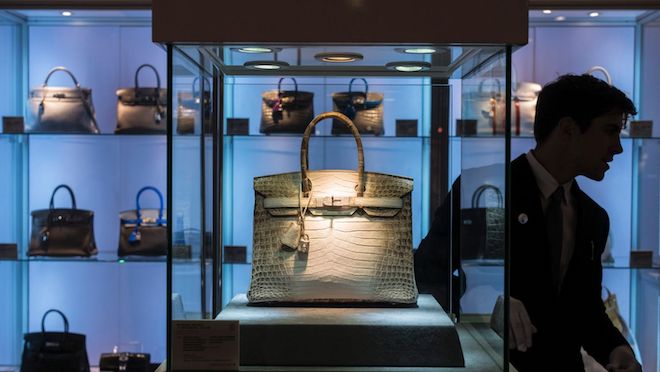Stella Lee, UOB Investment Writer, on why Birkins and investing are more alike than different
Vast majority of high end bags fail to qualify as investment assets because it depends on emotional appeal rather than rational, disciplined approaches. Birkins however, are an exception according to Stella Lee, writing for UOBAM invest.

You hear this phrase all the time. “Buying as an investment”.
As much as this gets thrown around when it comes to purchasing branded items, especially high-end bags, the vast majority fail to qualify as investment assets, despite their hefty price tag.
This is because luxury fashion as an industry is built on emotional appeal while investments are meant to be exercised with a rational and disciplined approach.
Buy high, sell higher: Investment writer Stella Lee on Why Birkins and investing are more alike than different
Those that make the cut as investment assets, quite often, witness generous annual appreciation values, placing themselves in the league of widely tracked indices including the S&P 500, which rose by an average of 14% per year in the last decade up till end June 2019, according to Bloomberg.
The trading of these coveted luxury items has become a big business. There is the Rare Handbag index which tracks the price trends of popular designer bags using an analysis of auctions and private sales. While this index increased 170% in absolute terms between 2004 and 2018, returns for mainstream assets such as oil rose only by 33% over the same period, according to Bloomberg statistics.
Due Diligence: Tips for Maximising your Investment in Birkins (and/or belts)
1. Classical economics
Prices go up when supply falls and demand surges.
Much of what makes these luxury items so valuable boils down to good old supply and demand dynamics.
Although demand for specific items can sometimes climb with a rare design which would make it a collector’s item, certain seasonal designs which fall out of production risk losing value as their visibility among buyers drops and their demand declines as a result. On the flip side, those worth buying tend to be staple items that are in constant production. To minimise price fluctuations, items are released in limited quantities to keep supply low and at the same time, ensures demand by having the items within sight of buyers.

2. Market sentiment
In this day and age of the internet, any hype created around products translates to demand. This parallels market sentiment, that is, the overall investor attitude towards the financial markets and is sometimes referred to as crowd psychology. For instance, when popularity and sales of a particular bag soars, the hype of an ‘IT bag’ is applied to cement its status.
A handful of designer houses are known as creators of these desirable bags rather than enjoying fame for one or two specific models. In finance, while past performance is not necessarily indicative of future performance, buying something from a label with a history of churning out hyped-up ‘IT bags’ increases the chances that you would be purchasing something of investment value.
3. Fundamental analysis
Fund managers recognise that the market can be irrational for periods of time, and turn to underlying principles of assessing investments using fundamental analysis for clarity.
Similar to how fund managers measure the intrinsic value of a stock using fundamental analysis, fashion enthusiasts look for features such as high quality craftsmanship, iconic design and colour etc, that renders a classic look and higher versatility of use.
Conversely, a design flaw in the item would likely render a negative impact on the resale value.

4. Technical analysis
The other major school of thought when it comes to approaching the markets lies with technical analysis which analyses historical market data such as price and volume.
When it comes to buying a designer items, ‘technical analysis’ can be gleaned from past reports of the volume. When these statistics are unavailable, access to forums, social media platforms, blogs and even magazines can gauge the level of interest around a product. Hence the number of mentions of a product in Facebook and Instagram are clues to the level of market demand for a luxury item.
5. Margins
The desirability and demand for any item can be gauged from the margins between the retail price from the designer store and the resale market price. More often than not, designer aficionados are more inclined to invest their monies in an item which can be resold at high values on the secondary market. The greater the desirability and enduring demand for the designer item, the higher the reselling price.
Furthermore, it is not uncommon to find online resellers listing highly-priced designer handbags a notch above retail or extremely popular ones fetching astronomical prices at auctions.
All in all
Investing into something carrying emotional value does not always translate into financial return. While a shrewd eye for designer goods as alternative investments is handy, gains in the luxury consumer discretionary sector are still dictated by an invisible hand, fed by human desire for status, beauty and exclusivity.

Notes:
From 2014 to 2018, the value of a Medium Classic Flap bag from Chanel increased in value by over 250% in absolute terms, according to the Rare Handbag index. The S&P 500 meanwhile rose by 205%. A separate study done by Baghunter and published with Business Insider in January 2016 revealed that the value of Hermès Birkin bags increased 500% in the last 35 years till 2017, an increase of 14.2% per year. By comparison, the S&P 500 saw an annual increase of 11.5% from during the same period.
All statistics on the S&P 500 are taken from Bloomberg as at 30 June 2019.
About Stella Lee
Stella Lee is a former TV reporter turned investment writer. The article was first drafted for UOBAM Invest, a digital corporate advisory service arm of UOB Asset Management.



